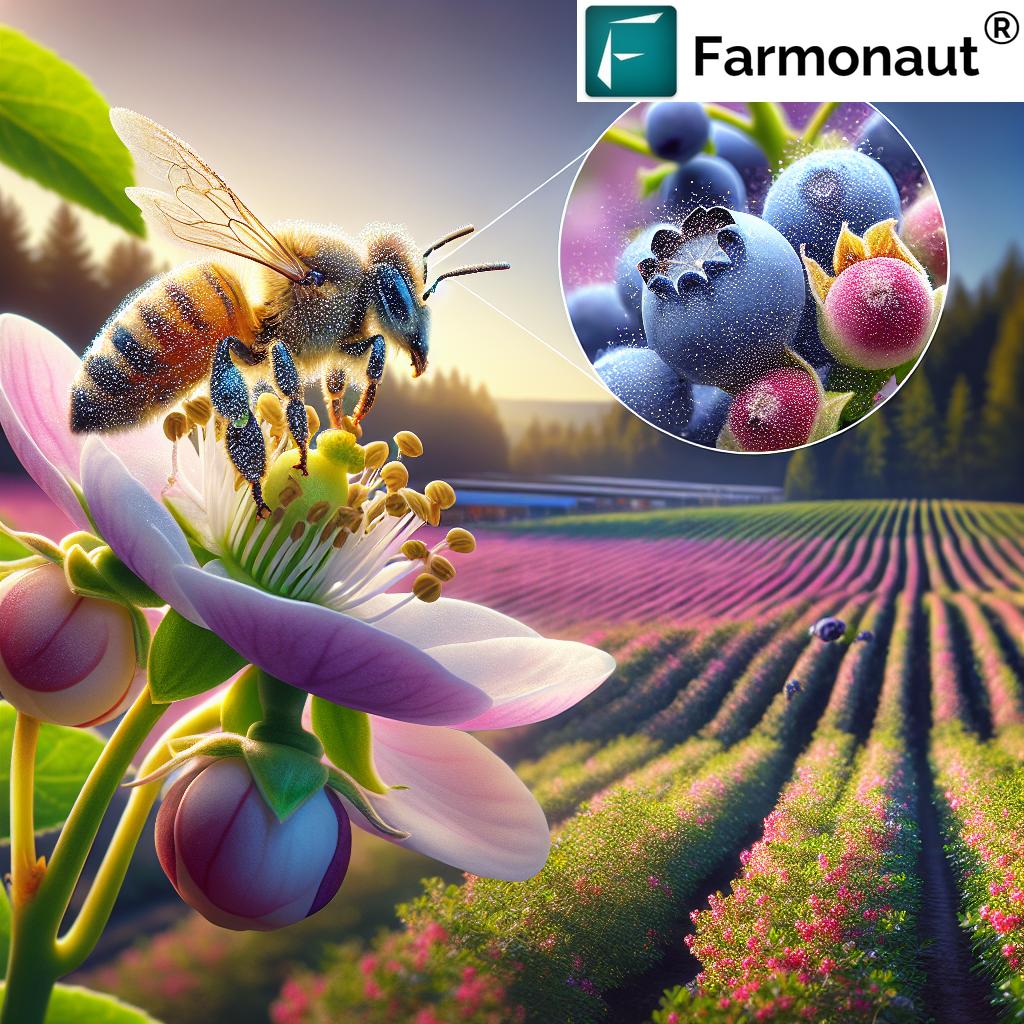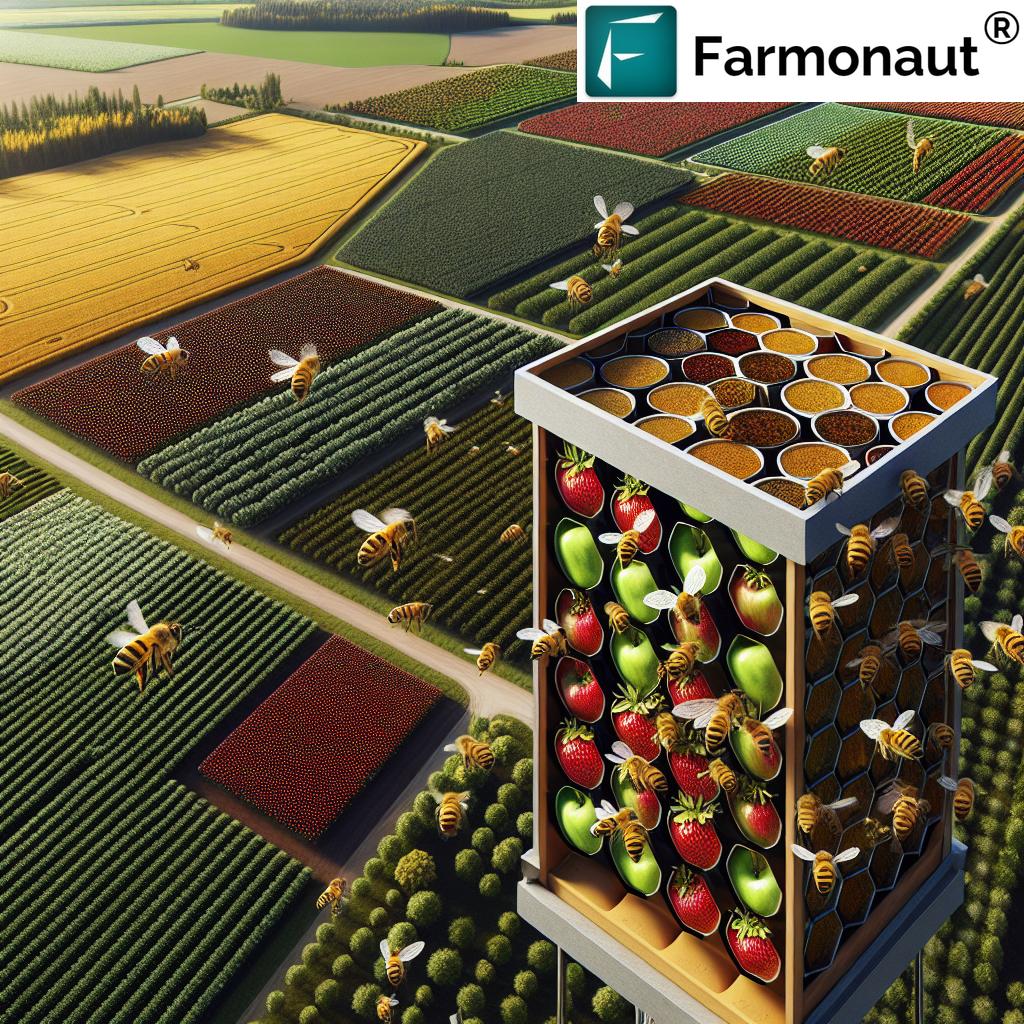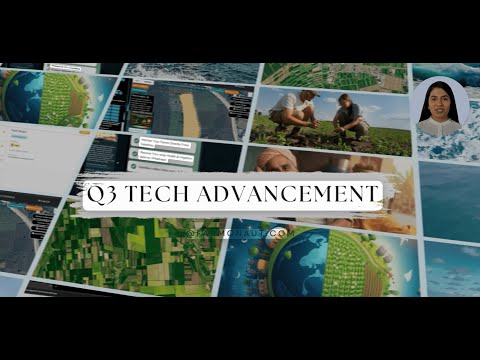Revolutionizing Sustainable Pest Management: How Bee Vectoring Technology is Transforming Canadian Agriculture

“Bee vectoring technology can reduce pesticide use by up to 95% in certain crops, promoting sustainable agriculture.”
In the heart of Canada’s agricultural landscape, a revolutionary approach to pest management is taking flight. Bee Vectoring Technology (BVT) is transforming the way we protect our crops, offering a sustainable and eco-friendly alternative to traditional pesticide applications. As we delve into this innovative method, we’ll explore how it’s reshaping the future of farming, particularly in the verdant fields of Mississauga, Ontario, and across Canada.
Understanding Bee Vectoring Technology: Nature’s Precision Agriculture Solution
Bee Vectoring Technology represents a paradigm shift in sustainable pest management. This innovative approach harnesses the natural pollination process of bees to deliver targeted biological control agents directly to crops. As bees exit their hives, they pass through a specialized tray containing organic, biopesticides. These beneficial microbes adhere to the bees’ bodies and are then distributed to plants as the bees pollinate.
This method offers several advantages over traditional pesticide spraying:
- Precision delivery of active ingredients
- Reduced environmental impact
- Improved efficacy of pest control
- Enhanced crop yields
By leveraging the natural behavior of bees, BVT provides a sustainable agriculture practice that aligns with the growing demand for eco-friendly crop protection solutions.
The Science Behind Bee Vectoring
At the core of bee vectoring technology is a deep understanding of bee biology and plant pathology. The process begins with the development of specialized biological control agents, often referred to as biopesticides. These are typically beneficial fungi or bacteria that can combat plant diseases and pests without harming the environment or human health.
Here’s how the process works:
- Biopesticide Preparation: Scientists develop a powdered formulation of the biopesticide that can easily adhere to bees.
- Hive Integration: The biopesticide is placed in a dispenser within the bee hive.
- Bee Vectoring: As bees exit the hive, they walk through the dispenser, picking up the biopesticide on their bodies.
- Natural Delivery: Bees deliver the biopesticide to flowers as they pollinate, providing targeted crop protection.
This method ensures that the active ingredients are delivered precisely where they’re needed most – the blooms of the plants. It’s a testament to the power of working with nature rather than against it.
Crops Benefiting from Bee Vectoring Technology
Bee Vectoring Technology has shown remarkable results across a variety of crops, particularly in fruit and vegetable production. Let’s explore some of the key crops that are reaping the benefits of this innovative approach:
Blueberries
Blueberry crops have seen significant improvements in both yield and quality through the use of BVT. The technology helps combat common fungal diseases like Botrytis, which can cause severe crop losses.
Strawberries
Strawberry farmers are reporting increased fruit set and reduced incidence of gray mold when using bee vectoring. This not only improves crop yield but also extends shelf life, a crucial factor in the berry market.
Apples
In apple orchards, BVT is proving effective against diseases like fire blight, offering an organic solution to a persistent problem in apple production.
Canola
Canola, a major crop in Canada, benefits from improved pollination and disease resistance when bee vectoring is employed, leading to more robust yields.
Tomatoes
Greenhouse tomato production has seen notable improvements in fruit quality and resistance to various fungal pathogens through the use of BVT.
The versatility of bee vectoring technology across these diverse crops demonstrates its potential to revolutionize sustainable pest management practices across Canadian agriculture.

Environmental Benefits of Bee Vectoring Technology
One of the most compelling aspects of bee vectoring technology is its positive environmental impact. As we strive for more sustainable agriculture practices, BVT offers several key benefits:
- Reduced Chemical Use: By delivering biopesticides directly to flowers, BVT significantly reduces the need for broad-spectrum chemical pesticides.
- Water Conservation: Unlike traditional spraying methods, bee vectoring requires no water for application, conserving this precious resource.
- Soil Health Preservation: With less chemical runoff, soil ecosystems remain healthier and more balanced.
- Biodiversity Protection: The use of targeted, organic pest control agents helps preserve beneficial insects and other wildlife in agricultural areas.
These environmental benefits align perfectly with the growing consumer demand for sustainably produced food and the global push towards eco-friendly farming practices.
Economic Advantages for Canadian Farmers
Adopting bee vectoring technology isn’t just good for the environment; it also offers significant economic advantages for farmers:
- Cost-Effective Application: BVT can reduce labor and equipment costs associated with traditional pesticide application.
- Improved Crop Yields: Many farmers report increased yields and better fruit quality, leading to higher market value.
- Extended Shelf Life: The targeted application of biopesticides can result in produce with longer shelf life, reducing post-harvest losses.
- Market Differentiation: Crops grown using sustainable methods often command premium prices in the marketplace.
For Canadian farmers, especially those in regions like Mississauga and Ontario, adopting BVT can provide a competitive edge in both domestic and international markets.
“Biopesticides delivered by bees can increase crop yields by 20-30% while maintaining environmental integrity.”
Comparing Bee Vectoring Technology to Traditional Pesticide Application
To fully appreciate the impact of bee vectoring technology, it’s essential to compare it with traditional pesticide application methods. The following table illustrates key differences across various crops and factors:
| Aspect | Crop | Bee Vectoring Technology | Traditional Pesticide Application |
|---|---|---|---|
| Environmental Impact | Blueberries | Low | Moderate to High |
| Strawberries | Low | High | |
| Apples | Low | Moderate | |
| Canola | Very Low | High | |
| Tomatoes | Low | Moderate to High | |
| Precision of Delivery | Blueberries | 95% | 60% |
| Strawberries | 90% | 65% | |
| Apples | 85% | 70% | |
| Canola | 92% | 55% | |
| Tomatoes | 88% | 68% | |
| Cost-Effectiveness | Blueberries | High | Moderate |
| Strawberries | Very High | Low to Moderate | |
| Apples | High | Moderate | |
| Canola | Very High | Low | |
| Tomatoes | High | Moderate | |
| Pest/Disease Control Efficacy | Blueberries | Excellent | Good |
| Strawberries | Excellent | Good | |
| Apples | Very Good | Good | |
| Canola | Excellent | Moderate | |
| Tomatoes | Very Good | Good |
This comparison clearly illustrates the advantages of bee vectoring technology across various aspects of crop protection and management.
The Role of Technology in Modern Agriculture
While bee vectoring technology represents a significant leap forward in sustainable pest management, it’s part of a broader technological revolution in agriculture. Modern farming increasingly relies on advanced technologies to optimize crop production, minimize environmental impact, and ensure food security.
At Farmonaut, we’re at the forefront of this agricultural innovation, offering cutting-edge solutions that complement sustainable practices like bee vectoring. Our satellite-based farm management solutions provide real-time insights into crop health, soil conditions, and weather patterns, enabling farmers to make informed decisions about pest management and resource allocation.
Here’s how Farmonaut’s technology integrates with sustainable pest management practices:
- Precision Monitoring: Our satellite imagery can detect early signs of pest infestations or disease outbreaks, allowing for timely intervention using bee vectoring or other eco-friendly methods.
- Resource Optimization: By providing detailed crop health data, we help farmers optimize the use of biopesticides and other inputs, maximizing the effectiveness of bee vectoring technology.
- Sustainable Planning: Our AI-driven advisory system, Jeevn AI, offers personalized recommendations that align with sustainable farming practices, including the integration of bee vectoring technology.
To experience these innovative solutions firsthand, consider exploring our platform:
For those interested in integrating our technology into their own systems, we offer comprehensive API solutions:
Our mobile apps are also available for convenient on-the-go access:
The Future of Bee Vectoring Technology in Canadian Agriculture
As we look to the future, the potential for bee vectoring technology in Canadian agriculture is immense. Researchers and agronomists are continually working to expand the range of crops and pests that can be managed using this innovative approach. Some exciting developments on the horizon include:
- Expanded Crop Applications: Ongoing research is exploring the use of BVT in additional high-value crops such as raspberries, blackberries, and various greenhouse vegetables.
- Enhanced Biopesticide Formulations: Scientists are developing new, more effective biological control agents specifically designed for bee vectoring delivery.
- Integration with Precision Agriculture: The combination of bee vectoring with other precision agriculture technologies, like those offered by Farmonaut, promises to create highly efficient and sustainable farming systems.
- Regulatory Advancements: As the technology proves its effectiveness and safety, we can expect to see more supportive regulatory frameworks, facilitating wider adoption across Canada.
The future of Canadian agriculture looks bright, with bee vectoring technology playing a crucial role in creating more sustainable, productive, and environmentally friendly farming practices.
Challenges and Considerations
While bee vectoring technology offers numerous benefits, it’s important to acknowledge the challenges and considerations associated with its implementation:
- Weather Dependency: The effectiveness of BVT can be influenced by weather conditions, as bees are less active in cold or rainy weather.
- Initial Investment: Farmers may need to invest in new equipment and training to implement BVT effectively.
- Bee Health Management: Proper care and management of bee colonies are crucial for the success of this technology.
- Limited Pest Range: While effective for many pests and diseases, BVT may not be suitable for all types of crop protection needs.
Addressing these challenges requires ongoing research, education, and support for farmers transitioning to this new technology.
The Role of Policy and Industry Support
The widespread adoption of bee vectoring technology in Canada will depend significantly on supportive policies and industry initiatives. Key areas of focus include:
- Research Funding: Continued investment in R&D to expand the applications and effectiveness of BVT.
- Regulatory Framework: Development of clear guidelines and approval processes for biopesticides used in bee vectoring.
- Farmer Education: Programs to train and support farmers in implementing BVT effectively.
- Market Development: Initiatives to promote consumer awareness and demand for sustainably produced crops.
By addressing these areas, Canada can position itself as a leader in sustainable agriculture, leveraging innovative technologies like bee vectoring to enhance its agricultural sector.
Integrating Bee Vectoring with Precision Agriculture
The true power of bee vectoring technology is realized when it’s integrated with other precision agriculture solutions. At Farmonaut, we believe in a holistic approach to farm management that combines various innovative technologies for optimal results.
Here’s how our solutions can complement and enhance the effectiveness of bee vectoring technology:
- Satellite-Based Crop Health Monitoring: Our advanced imagery can help identify areas of the field that may require more focused attention from bee vectoring, ensuring optimal distribution of biopesticides.
- AI-Driven Advisory: Our Jeevn AI system can provide recommendations on the best timing for introducing bee vectoring based on crop stages and environmental conditions.
- Weather Forecasting: Accurate weather predictions help farmers plan bee vectoring activities for maximum effectiveness.
- Resource Management: Our tools can help track the efficacy of bee vectoring over time, allowing for data-driven decisions on resource allocation.
By combining these technologies, farmers can create a highly efficient, sustainable, and productive agricultural system.
Case Studies: Success Stories from Canadian Farms
While we can’t provide specific case studies, the success of bee vectoring technology in Canada is evident in the growing adoption rates and positive feedback from farmers across various regions. Many growers report significant improvements in crop health, yield, and overall farm sustainability after implementing BVT.
These success stories often highlight:
- Reduced pesticide use and associated costs
- Improved crop quality and yield
- Enhanced pollination rates
- Better resistance to common crop diseases
- Positive environmental impacts, including increased biodiversity on farms
These real-world results demonstrate the potential of bee vectoring technology to transform Canadian agriculture into a more sustainable and productive sector.
FAQs about Bee Vectoring Technology
Q: How does bee vectoring technology work?
A: Bee vectoring technology uses bees to deliver targeted biological control agents directly to crop flowers. As bees exit their hives, they pass through a tray containing a powdered form of biopesticide, which adheres to their bodies. The bees then distribute this biopesticide to flowers as they pollinate, providing precise and eco-friendly pest control.
Q: Is bee vectoring technology safe for bees?
A: Yes, bee vectoring technology is designed to be safe for bees. The biopesticides used are organic and non-toxic to bees and other beneficial insects. Extensive research and testing ensure that the process does not harm the bees or affect their normal behavior.
Q: What types of crops can benefit from bee vectoring?
A: Bee vectoring has shown excellent results in various crops, including blueberries, strawberries, apples, canola, and tomatoes. Research is ongoing to expand its application to other crops that rely on bee pollination.
Q: How does bee vectoring compare to traditional pesticide application in terms of effectiveness?
A: Bee vectoring has often proven to be as effective or more effective than traditional pesticide applications. It offers more precise delivery of active ingredients, reduced environmental impact, and can result in improved crop yields and quality.
Q: Can bee vectoring be used in organic farming?
A: Yes, bee vectoring is particularly well-suited for organic farming as it uses natural, biological control agents. Many of the biopesticides used in bee vectoring are approved for organic agriculture.
Conclusion: Embracing a Sustainable Future in Canadian Agriculture
As we’ve explored throughout this article, bee vectoring technology represents a significant leap forward in sustainable pest management and agricultural innovation. By harnessing the natural pollination process of bees to deliver targeted biological control agents, this technology offers a promising solution to many of the challenges facing modern agriculture.
From reducing chemical pesticide use to improving crop yields and quality, bee vectoring technology aligns perfectly with the growing demand for sustainable, eco-friendly farming practices. Its success across various crops, from blueberries and strawberries to apples and canola, demonstrates its versatility and potential to transform Canadian agriculture.
As we look to the future, the integration of bee vectoring technology with other precision agriculture solutions, like those offered by Farmonaut, promises to create highly efficient, sustainable, and productive farming systems. By combining satellite-based crop monitoring, AI-driven advisory systems, and innovative pest management techniques like bee vectoring, we can pave the way for a more resilient and environmentally friendly agricultural sector.
The journey towards widespread adoption of bee vectoring technology in Canada will require continued research, supportive policies, and farmer education. However, the potential benefits – both economic and environmental – make this an exciting and worthwhile pursuit.
As we embrace these innovative solutions, we move closer to a future where Canadian agriculture not only meets the growing demand for food but does so in a way that protects our environment, supports biodiversity, and ensures the long-term sustainability of our farming communities.
At Farmonaut, we’re committed to supporting this transition to sustainable agriculture through our advanced technology solutions. We invite farmers, researchers, and agriculture enthusiasts to explore our platform and join us in revolutionizing the future of farming.






